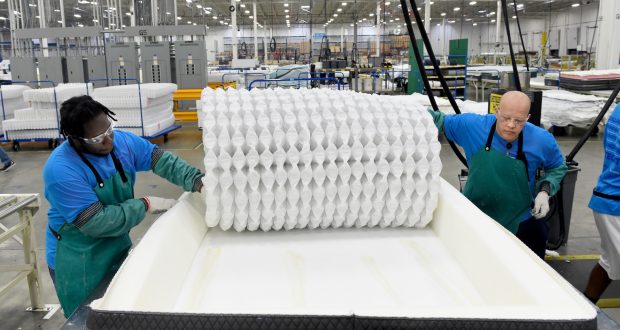After the consumption boom during the pandemic, it seems that the “golden age” of US mattress industry is coming to an end. Despite all the factors such as excess inventory, high inflation, and declining employment rates still affecting the market, the mattress industry is poised for a new turning point in 2023.
seems that the “golden age” of US mattress industry is coming to an end. Despite all the factors such as excess inventory, high inflation, and declining employment rates still affecting the market, the mattress industry is poised for a new turning point in 2023.
The supply situation of TDI (Toluene Diisocyanate), an important raw material for mattresses, has also attracted attention during this market volatility. TDI is a major component of polyurethane foam, which is widely used in mattress manufacturing to provide superior comfort and support. However, the supply of TDI is relatively tight due to price fluctuations and limited production capacity of its raw materials, namely benzene and toluene. Moreover, the demand has kept declining, and major financial pressures faced by U.S. consumers include inflation, economic recession, high housing prices, and high interest rates. As a result, the demand for mattresses has been relatively weak.
Owing to economic uncertainty, it is expected that mattress sales will experience a decline in both volume and value in 2023, with a potential recovery in 2024, according to the latest forecast by International Sleep Products Association (ISPA). ISPA predicts a 6% year-on-year decrease in total mattress sales in 2023, amounting to approximately 40.6 million pieces, and a 3% decrease in sales value, amounting to USD 10.248 billion. This implies that mattress manufacturers and suppliers will face significant pressure and will need to seek innovative solutions to maintain business stability.
But looking further ahead into 2024, there is a glimmer of hope. As mortgage rates are projected to ease up and the housing sector begins to recover, the mattress industry is also expected to be benefited. ISPA predicts that the total mattress sales will increase by 3%, at 41.8 million pieces, and the value will increase by 5%, at USD 10.76 billion, in 2024 as compared with 2023. This indicates that the mattress industry may gradually emerge from the downturn and enter a new growth cycle.
Jerry Epperson, an analyst at Mann, Armistead & Epperson, shares a positive outlook for the mattress industry, aligning with ISPA’s predictions. He provides three reasons: Firstly, the Federal Reserve is raising its key interest rate by 0.25%, which will help stabilize the economy. Secondly, inflation is cooling off, easing market uncertainty. Thirdly, both existing and new home sales have shown positive results in recent months, which will boost the demand for mattresses. The U.S. home builder confidence hit a 13-month high in July, according to National Association of Home Builders (NAHB). With tight housing supply, buyers continue to choose newly constructed homes, driving increased demand for furniture and mattresses.
Despite multiple challenges, the mattress industry still holds immense potential. As people’s emphasis on health and sleep quality continues to grow, the functionality and comfort of mattresses will become crucial factors for consumer choices. Therefore, mattress manufacturers need to not only pay attention to changes in the supply chain and economic environment but also constantly innovate products and technologies to meet the ever-changing market demand.
Overall, the U.S. mattress industry may be going through a downturn at the moment, but the future is still promising. By optimizing the use of raw materials like TDI and implementing eco-friendly technologies, as well as accurately understanding market demand, mattress manufacturers will have the opportunity to create new development opportunities and embrace the challenges and changes in the industry.
 SleepTech Magazine Mattress, Accessories, Machinery, Raw Materials
SleepTech Magazine Mattress, Accessories, Machinery, Raw Materials



